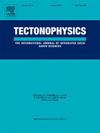Horcón盆地(智利中部~33°S)上新世—更新世地层学:胡安Fernández海隆起的海侵—海退旋回与弧前变形
IF 2.6
3区 地球科学
Q2 GEOCHEMISTRY & GEOPHYSICS
引用次数: 0
摘要
根据沉积学、地层学和UPb碎屑锆石年代学资料,分析了中安第斯山脉弧前盆地Horcón(32°-33°S)新近系至第四纪的海相和陆相演替。该盆地位于Juan Fernández脊(JFR)现今的投影之上,该脊在过去的约1000万年中一直以一个固定的切入点俯冲到南美洲板块之下。早期海侵期(上新世晚期)记录在从中过渡到较深近海环境的序列中。覆盖在这些沉积物上的明显侵蚀面标志着随后的退退阶段。随后发生了第二次海侵(早更新世?),保存在以砾石状上滨面至前滨相为主的向上加深层序中。较晚的退行期(早更新世至中更新世?)表现为泥石流沉积和广泛的冲积河滩向海岸逐渐推进。碎屑锆石UPb年龄和砾石组成表明,在整个盆地演化过程中,海岸科迪勒拉的侏罗纪和白垩纪弧岩是沉积物的主要来源,其中主要来自主科迪勒拉,可能与阿空加瓜河上游的构造活动有关。我们认为第一次海侵事件可能反映了区域沉降,而随后的回归可能与南美边缘在这些纬度的区域隆升有关。此外,Horcón盆地记录的海侵-海退旋回可能记录了由海岸正断层驱动的局部垂直运动,导致高凸起的海岸块体和海湾。虽然还需要进一步的证据,但我们认为,这种发生在整体压缩状态下的复杂变形历史可能受到JFR海山俯冲的调节,导致了上覆板块边缘的局部沉降和隆起。本文章由计算机程序翻译,如有差异,请以英文原文为准。
Plio–Pleistocene stratigraphy of the Horcón Basin (central Chile, ∼33°S): Transgressive–regressive cycles and forearc deformation above the Juan Fernández Ridge
This paper analyzes the marine and continental successions of the Neogene to Quaternary Horcón Basin (32°–33°S), a forearc basin of the Central Andes, based on sedimentological, stratigraphic, and U![]() Pb detrital zircon geochronological data. The basin lies above the present-day projection of the Juan Fernández Ridge (JFR), which has been subducting beneath the South American Plate at a fixed piercing point over the past ∼10 million years. An initial transgressive episode (Late Pliocene) is recorded in successions that grade from middle transitional to deeper offshore settings. A prominent erosional surface overlying these deposits marks a subsequent regressive phase. This was followed by a second transgression (Early Pleistocene?), preserved in a deepening-upward sequence dominated by gravelly upper shoreface to foreshore facies. A later regression (Early to Middle Pleistocene?) is expressed by debris flow deposits and extensive alluvial braidplains progradationally advancing toward the coast. Detrital zircon U
Pb detrital zircon geochronological data. The basin lies above the present-day projection of the Juan Fernández Ridge (JFR), which has been subducting beneath the South American Plate at a fixed piercing point over the past ∼10 million years. An initial transgressive episode (Late Pliocene) is recorded in successions that grade from middle transitional to deeper offshore settings. A prominent erosional surface overlying these deposits marks a subsequent regressive phase. This was followed by a second transgression (Early Pleistocene?), preserved in a deepening-upward sequence dominated by gravelly upper shoreface to foreshore facies. A later regression (Early to Middle Pleistocene?) is expressed by debris flow deposits and extensive alluvial braidplains progradationally advancing toward the coast. Detrital zircon U![]() Pb ages and gravel composition indicate sediment sources from Jurassic and Cretaceous arc rocks of the Coastal Cordillera throughout the basin's evolution, with a significant contribution from the Principal Cordillera possibly linked to tectonic activity upstream of the Aconcagua River. We suggest that the first transgressive episode may reflect regional subsidence, whereas the subsequent regression could be associated with regional uplift of the South American margin at these latitudes. Additionally, the transgressive–regressive cycles documented in the Horcón Basin likely record localized vertical motions driven by coastal normal faulting, resulting in high-relief coastal blocks and embayments. While further evidence is needed, we propose that this complex deformation history, occurring within an overall compressive regime, may have been modulated by the subduction of JFR seamounts, contributing to localized subsidence and uplift along the margin of the overriding plate.
Pb ages and gravel composition indicate sediment sources from Jurassic and Cretaceous arc rocks of the Coastal Cordillera throughout the basin's evolution, with a significant contribution from the Principal Cordillera possibly linked to tectonic activity upstream of the Aconcagua River. We suggest that the first transgressive episode may reflect regional subsidence, whereas the subsequent regression could be associated with regional uplift of the South American margin at these latitudes. Additionally, the transgressive–regressive cycles documented in the Horcón Basin likely record localized vertical motions driven by coastal normal faulting, resulting in high-relief coastal blocks and embayments. While further evidence is needed, we propose that this complex deformation history, occurring within an overall compressive regime, may have been modulated by the subduction of JFR seamounts, contributing to localized subsidence and uplift along the margin of the overriding plate.
求助全文
通过发布文献求助,成功后即可免费获取论文全文。
去求助
来源期刊

Tectonophysics
地学-地球化学与地球物理
CiteScore
4.90
自引率
6.90%
发文量
300
审稿时长
6 months
期刊介绍:
The prime focus of Tectonophysics will be high-impact original research and reviews in the fields of kinematics, structure, composition, and dynamics of the solid arth at all scales. Tectonophysics particularly encourages submission of papers based on the integration of a multitude of geophysical, geological, geochemical, geodynamic, and geotectonic methods
 求助内容:
求助内容: 应助结果提醒方式:
应助结果提醒方式:


